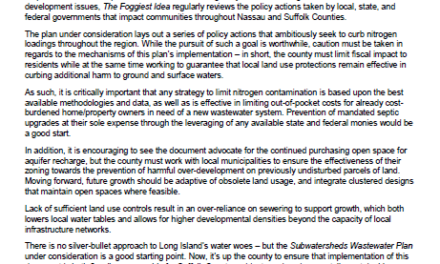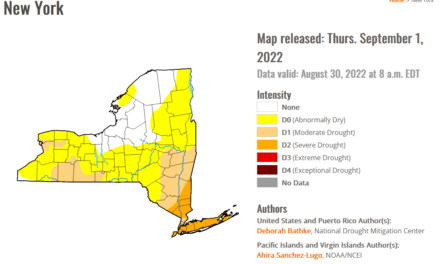The following was written on the day of the third and final public hearing of the Long Island Water Quality Task Force, held at Suffolk Community College’s Brentwood Campus.
Today is the third and final public meeting of the Long Island Water Quality Task Force, created by Gov. Andrew Cuomo to tackle Nassau and Suffolk’s regional water issues.
I plan on attending the meeting, being held this afternoon at Suffolk County Community College’s Brentwood campus, and will be arguing for the integration of sound urban planning principles to accompany the much needed wastewater infrastructure expansions.
It’s been studied, assessed and analyzed a multitude of times, and the verdict is always the same: The linkage between land use and water quality on Long Island not only exists, but sound urban planning principles put into practice can effectively protect our aquifer system for future generations. Policymakers must use previous studies conducted as a solid foundation for this next effort and not waste time reinventing the wheel.
What is critical to effectively protecting our aquifers is acceptance that sewers aren’t the silver bullet approach many are touting them to be. In an insightful piece on the topic earlier this month, Karl Grossman explored what really is behind the “drive for sewering” in Suffolk County. He wrote:
The biggest scandal in Suffolk in the last 50 years involved the Southwest Sewer District. Development and heavy construction interests — which profited greatly from the sewer work — pushed that $1 billion project. Is history repeating itself in Suffolk?
It seems the answer is yes. Despite the seemingly stacked policy deck toward wastewater expansion, the public can make their voices heard both tonight, and to their elected officials. Many deride government and civic processes, but few participate. Sewers are not a particularly sexy topic, but they will impact this region for decades both environmentally and fiscally.
Are expansions of the sewer network needed? Yes. Are they the only solution to our water woes? Far from it. Help protect our drinking and surface waters, and participate in the civic process. If you’re in the area this afternoon, stop by the public hearing.
The more Long Islanders that become involved, the less influence the stale stakeholders and their stale solutions will have.













